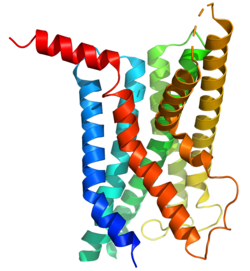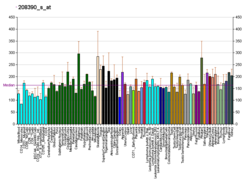Top Qs
Timeline
Chat
Perspective
Glucagon-like peptide-1 receptor
Receptor activated by peptide hormone GLP-1 From Wikipedia, the free encyclopedia
Remove ads
The glucagon-like peptide-1 receptor (GLP1R) is a G protein-coupled receptor (GPCR) found on beta cells of the pancreas and on neurons of the brain. It is involved in the control of blood sugar level by enhancing insulin secretion. In humans it is synthesised by the gene GLP1R, which is present on chromosome 6.[5][6] It is a member of the glucagon receptor family of GPCRs.[7] GLP1R is composed of two domains, one extracellular (ECD) that binds the C-terminal helix of GLP-1,[8] and one transmembrane domain (TMD)[9] that binds the N-terminal region of GLP-1.[10][11][12] In the TMD domain a fulcrum of polar residues regulates the biased signaling of the receptor [10] while the transmembrane helical boundaries[13] and extracellular surface are a trigger for biased agonism.[11]
Remove ads
Ligands
GLP1R binds glucagon-like peptide-1 (GLP1) and glucagon as its natural endogenous agonists.[14]
- GLP-1 – endogenous in humans[14]
- glucagon – endogenous in humans[14]
- oxyntomodulin
- amycretin
- exendin-4[14][15]
- exenatide
- lixisenatide[14]
- albiglutide
- beinaglutide
- dulaglutide
- efpeglenatide
- langlenatide
- liraglutide[14]
- polyethylene glycol/PEG- loxenatide
- semaglutide
- taspoglutide
- ecnoglutide
- utreglutide
- glepaglutide
- apraglutide
- maridebart cafraglutide
- tirzepatide
- pegapamodutide
- mazdutide
- survodutide
- bamadutide
- pemvidutide
- cotadutide
- retatrutide
- lithium chloride
- cinchonine
- grutalumab
- dapiglutide
- DA1726
- GX-G6
- GZR18
- HRS9531
- PB718
- RAY1225
- VCT220
- VK2735
- BLX7006
supaglutide/efsubaglutide
- ASC30
- danuglipron
- aleniglipron
- lotiglipron
- orforglipron
- CT-996
- CT-388
- CT-868
- HEC88473
- HS-10535
- UBT251
- efinopegdutide
- efocipegtrutide
- NNC9204-1706
- TG103
- YP05002/YP-05002
- [9-39]-GLP-1
- T-0632
- GLP1R0017[16]
- avexitide / exendin 9-39
- Positive:
- BETP
- Negative:
- HTL26119[17]
Remove ads
Structure

The GLP-1 receptor is a transmembrane protein composed of seven alpha-helical transmembrane domains (TM1-TM7), an extracellular N-terminus, and an intracellular C-terminus. It belongs to the class B family of G protein-coupled receptors, also known as secretin-like receptors. The extracellular N-terminus contains key regions involved in ligand recognition and binding. It undergoes conformational changes upon ligand binding, leading to activation of intracellular signaling cascades. The intracellular C-terminus interacts with G proteins and other signaling molecules to initiate cellular responses.
Remove ads
Function
Glucagon-like peptide-1 (GLP-1) is a hormone consisting of 30 amino acids. GLP-1 is released by intestinal L cells when nutrients are consumed. GLP1R is expressed on beta cells in the pancreas. Binding of GLP-1 to GLP1R has multiple effects, including enhancing insulin secretion from pancreatic beta cells in response to glucose, increasing insulin expression, preventing beta-cell apoptosis, promoting the formation of new beta cells, reducing glucagon secretion, slowing down stomach emptying, promoting satiety, and improving glucose disposal in peripheral tissues.
GLP1R is also expressed in the brain[18] where it is involved in the control of appetite.[19]
Mechanism of action
Upon binding to its ligand GLP-1, the GLP-1 receptor activates intracellular signaling pathways that regulate insulin secretion, glucose metabolism, and satiety.
In pancreatic beta cells, GLP-1 receptor activation enhances glucose-stimulated insulin secretion. This occurs through the activation of adenylyl cyclase, leading to increased intracellular levels of cyclic AMP (cAMP). The rise in cAMP activates protein kinase A (PKA), which promotes insulin exocytosis and enhances beta cell survival and proliferation. GLP-1 receptor signaling in pancreatic alpha cells reduces glucagon secretion, further contributing to glucose lowering.
Activation of GLP-1 receptor delays the rate at which the stomach empties, leading to increased satiety and feeling of fullness.
Activation of the GLP-1 receptor in the brain promotes feelings of satiety.[19]
Remove ads
Clinical significance
GLP-1 receptor agonists are a class of medications that mimic the actions of the endogenous incretin hormone GLP-1, and are used in type 2 diabetes and obesity.
References
Further reading
External links
Wikiwand - on
Seamless Wikipedia browsing. On steroids.
Remove ads








